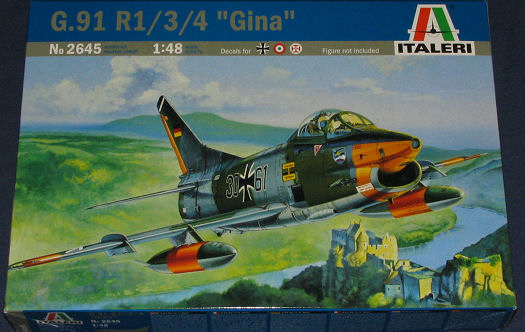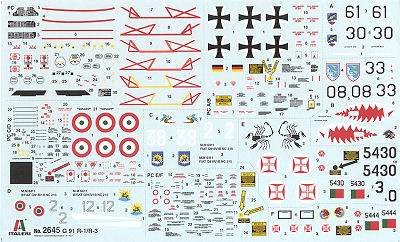
| KIT: | Italeri 1/48 Fiat G.91R |
| KIT #: | 2645 |
| PRICE: | $31.00 |
| DECALS: | Six options |
| REVIEWER: | Scott Van Aken |
| NOTES: | Re-boxed ESCI kit |

| HISTORY |
Designed in response to a 1953 request for a European lightweight strike fighter, the G.91 first flew in 1956 with completion against the Northrop F-5A, Dassault Etendard IV and several other aircraft. Eventually, the British pulled out to develop the Hawker Hunter, while the French decided to work on its many inputs to the competition independently. The Italian government gave the go-ahead while the competition was underway and those pre-production aircraft were eventually used by the Italian display team, the Frecci Tricolori.
Aeritalia built 174 G.91s for Italy, plus 144 for Germany (including 50 that had been ordered and then cancelled by Greece and Turkey). Another 294 were built in Germany by Flugzeug-Union Süd (a consortium of former competitors Messerschmitt, Heinkel, and Dornier). The type was also considered by Austria, Norway, Switzerland, and even the United States Army, which briefly evaluated the type as a possible Forward Air Control (FAC) aircraft before relinquishing all fixed-wing aircraft operations to the USAF.
From 1961, Portugal began to purchase the G.91 to deploy to her former African colonies of Mozambique, Guinea-Bissau, and Angola in the close-support role. The first 40 were purchased second-hand from the Luftwaffe out of the aircraft that had originally been produced for Greece and which differed from the rest of the Luftwaffe G.91s sufficiently to create maintenance problems. The aircraft replaced the F-86 Sabres, which were withdrawn following US protests over the use of these aircraft that had originally been supplied for defensive purposes. Portuguese G.91s continued in this role until the withdrawal from Africa in 1975.
Portugal finally phased out the last of her G.91s in 1993, and Italy in 1995. There are numerous examples preserved in museums around the world.
| THE KIT |
 This
is a re-boxing of the older ESCI kit. As such, the kit is of the raised panel
line era. The detail, though raised is very well done and captures the look of
this aircraft. One thing that clearly came across while looking at the sprues is
that this particular set seem to have been run off the machines a bit quickly as
there are numerous sink areas to fill. The most egregious are on the upper wing
opposite the gear posts, on the fuselage nose gear doors and aft section near
the exhaust, and on one set of main landing gear doors. None are irreparable,
but they shouldn't be there at all. There are others, but they are of a lesser
concern. There are the usual ejector pin marks on landing gear and gear doors,
but nothing outside of the norm for kits of this age.
This
is a re-boxing of the older ESCI kit. As such, the kit is of the raised panel
line era. The detail, though raised is very well done and captures the look of
this aircraft. One thing that clearly came across while looking at the sprues is
that this particular set seem to have been run off the machines a bit quickly as
there are numerous sink areas to fill. The most egregious are on the upper wing
opposite the gear posts, on the fuselage nose gear doors and aft section near
the exhaust, and on one set of main landing gear doors. None are irreparable,
but they shouldn't be there at all. There are others, but they are of a lesser
concern. There are the usual ejector pin marks on landing gear and gear doors,
but nothing outside of the norm for kits of this age.
The interior consists of a tub that forms part of the intake. A seat and control stick are supplied with the rudder pedals molded onto the tub floor. Separate instrument panel and side consoles are provided; all of which get decals for instruments. There is a nicely detailed main wheel well/speed brake well. No actuators are supplied for the speed brakes. Landing gear are a tad on the generic side with enough detail to satisfy most modelers. The gun bays are able to handle the required armament for the version you are building. Included are the different style bay covers for the two or four gun variant. This same differentiation continues with the cockpit canopy as two versions are supplied. Finally there are three options for the wing pylons; drop tanks, bombs or rocket pods.
 Instructions
are the usual high Italeri quality with ModelMaster color information. Markings
are provided for six aircraft on a huge decal sheet. It seems that when Italeri
re-pops an ESCI kit, they provide an incredible decal sheet. There are two
German G.91R-3s; one from WaSLW 50 and the other from LKG 43, both in Dark
Green/Dark Grey over Aluminum. The WaSLW 50 aircraft is the box art and the
other has a large sharkmouth. The two Italian options are in the same colors as
the German ones. One option is from 1973 and the other from 1991. Both are 2
Stormo, but the insignia and lettering is quite different. Finally, two
Portuguese aircraft. One is from EdA 702 and is in light grey with a huge
scorpion on the side. The other is from Esc 301 in 1981. This one is painted in
Dark Green/Dark Tan over Light Grey. I'd personally take some of the color info
with a grain of salt and find a more accurate reference on the net with RAL and
proper NATO colors. An aside is that the Portuguese G.91s ended their career in
a wraparound scheme with the smaller insignia in case you wanted to do one of
those with the kit decals. The sheet is well printed and quite matte.
Instructions
are the usual high Italeri quality with ModelMaster color information. Markings
are provided for six aircraft on a huge decal sheet. It seems that when Italeri
re-pops an ESCI kit, they provide an incredible decal sheet. There are two
German G.91R-3s; one from WaSLW 50 and the other from LKG 43, both in Dark
Green/Dark Grey over Aluminum. The WaSLW 50 aircraft is the box art and the
other has a large sharkmouth. The two Italian options are in the same colors as
the German ones. One option is from 1973 and the other from 1991. Both are 2
Stormo, but the insignia and lettering is quite different. Finally, two
Portuguese aircraft. One is from EdA 702 and is in light grey with a huge
scorpion on the side. The other is from Esc 301 in 1981. This one is painted in
Dark Green/Dark Tan over Light Grey. I'd personally take some of the color info
with a grain of salt and find a more accurate reference on the net with RAL and
proper NATO colors. An aside is that the Portuguese G.91s ended their career in
a wraparound scheme with the smaller insignia in case you wanted to do one of
those with the kit decals. The sheet is well printed and quite matte.
| CONCLUSIONS |
OK, so it isn't a brand new mold. Not a surprise for most of us as these things cost a LOT of money. Still, you have a very nice kit from the past that will be able to give the Ocidental/Heller kit a run for the money. In addition, you can do all the different versions aside from the PAN aircraft and have a great decal sheet to go along with it.
January 2006
| REFERENCES |
The 'internet'.
Thanks to
 for the review kit. You can find Italeri kits at your favorite hobby shop
or on-line at
www.testors.com
for the review kit. You can find Italeri kits at your favorite hobby shop
or on-line at
www.testors.com
If you would like your product reviewed fairly and fairly quickly by a site that has over 300,000 visitors a month, please contact me or see other details in the Note to Contributors.